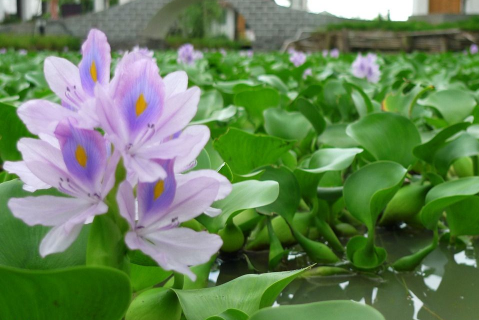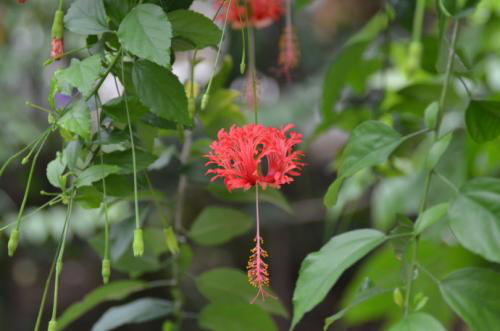The reason why water lilies do not blossom
1. Lighting reason
Water lilies do not bloom to a large extent due to a variety of reasons. Water lilies need plenty of light to grow, and if not enough light will make their branches and leaves more luxuriant, resulting in no flowering. If you keep it in the shade for a long time, there will be moss on the water surface, and the plant will be weak, so it will stop growing leaves and not blossom.
two。 Undivided plants for a long time
Potted water lilies had better be ramified once a year. Long-term non-ramification will make the roots become densely blocked and grow poorly, thus affecting flowering.
3. Planting density
When planting water lilies should not be too dense, otherwise it will make the basin crowded, affect the light, the leaves are too dense, and then poor ventilation, which is not conducive to plant growth.
4. Excessive base fertilizer
Excessive application of basal fertilizer in the early growth stage of water lilies is not conducive to its flowering. If the soil is not good, it will also cause nutrient loss, causing the water lilies not to blossom.
Why water lilies only grow leaves but do not blossom? What if water lilies don't blossom?
Whether potted or pond-raised water lilies, do not like the phenomenon of flowering occurs from time to time. Flower growers can only manage accordingly according to the specific situation, and they will soon be able to reverse the situation that water lilies do not like to blossom. The following editor will introduce to you the reasons why water lilies do not blossom and the countermeasures.
1. Getting into the water too deep
If the water layer above the plant is too thick, the more nutrients the leaves and buds need to float to the surface. Under normal circumstances, there is a water layer about 15 cm thick above the top bud of water lilies. Only in this way can the plant bloom normally.
2. Insufficient fertilizer
For water lilies that like big fat, if they do not apply enough fertilizer at the time of planting or use enough topdressing during the vigorous growth season, it is especially easy to lead to the phenomenon of fewer flowers or flowers at all. Therefore, in order to make water lilies blossom and flourish, it is very necessary to use enough fertilizer in time.
3. Environmental shade
Water lilies can grow well in a strong sunny environment, the cultivation site is shady, and the plant buildings are unable to synthesize a large amount of nutrients needed for normal flowering, so they often do not like to blossom. It should be remembered that in order to make water lilies bloom, they should be exposed to no less than 4 hours of direct sunlight every day.
4. The temperature is low
After autumn, with the decrease of temperature, the number of flowers will decrease day by day. If you want the water lilies to continue to blossom, you can try to increase the temperature of the environment. For example, measures such as covering plastic film are used to improve the local temperature of the cultivation environment. This can effectively promote the normal flowering of the plant, and then improve the ornamental value of the water lily itself.
The above are the reasons and countermeasures for the non-flowering of water lilies introduced by the succulent flower bed. I hope it will be helpful to you. Welcome to continue to pay attention to the succulent flower bed and learn more about the maintenance of aquatic flowers.
When do water lilies bloom? when do water lilies bloom?
Water lily is one of people's favorite flowers, it can not only decorate the room and purify the air, but also has a beautiful color and unique shape, which can give people a sense of peace of mind. Water lilies have good growth habits and are suitable for indoor cultivation and have been planted in various areas of our country. So, when do water lilies blossom? Today, the editor will show you the flowering time of water lilies.
The leaves of the sleeping lotus are round or nearly round, or oval, while some varieties are lanceolate or arrow-shaped, the leaves are entire, but the leaf edges of tropical water lilies are corrugated, the leaves are green, bright, and the back is purplish red, and the pages of some varieties have dark brown spots or mottled colors, and the veins are obvious or not obvious.
To know when water lilies bloom, we need to know their growth habits:
Sleeping lotus flowers like sunshine and are well ventilated, so tropical and hardy water lilies that bloom during the day close at night and bloom again in the morning. Ponds with shady trees on the bank can blossom, but grow weakly.
Flowering time of water lilies
The sleeping lotus sprouts with long leaves from March to April, blossoms one after another from May to August, and each flower blossoms for 2 to 5 days. Bear fruit after flowering. The stems and leaves withered from October to November. It sprouted again the following spring.
It germinated from late March to early April, pregnant buds in late April or early May, bloomed from June to August, yellow leaves from October to November, and entered dormancy period after November. Born in ponds and lakes, it is often cultivated in the pools of some parks.
The above is a simple summary of when water lilies bloom. Water lilies can be sown all the year round and like the environment where there is plenty of light and rich organic matter and rich clay. Water lilies are not tolerant to shade, and the suitable temperature for growth is 20-30 ℃. When planting, we should pay attention not to be too low to avoid growth stagnation.
- Prev

Matters needing attention in the culture of Phoenix blue
1. Under ventilated conditions, the plants should be protected in a well-ventilated environment to keep the air fresh, and Phoenix blue will grow more vigorously. two。 Apply sufficient base fertilizer before fertilization and planting, and often topdressing during the growth period, preferably with mature farm manure diluted in concentration. Be careful not to sprinkle it directly on the seedlings when topdressing.
- Next

Matters needing attention in raising mulberry potted plants with family chandelier
1. Root-knot nematode disease is a widely distributed and serious disease, especially in the process of chandelier mulberry culture, when reddish-brown spots appear on the edge of leaves. When expanding inward, be careful. At this time, the soil can be changed and aldicarb granules can be applied to the new soil.
Related
- Fuxing push coffee new agricultural production and marketing class: lack of small-scale processing plants
- Jujube rice field leisure farm deep ploughing Yilan for five years to create a space for organic food and play
- Nongyu Farm-A trial of organic papaya for brave women with advanced technology
- Four points for attention in the prevention and control of diseases and insect pests of edible fungi
- How to add nutrient solution to Edible Fungi
- Is there any good way to control edible fungus mites?
- Open Inoculation Technology of Edible Fungi
- Is there any clever way to use fertilizer for edible fungus in winter?
- What agents are used to kill the pathogens of edible fungi in the mushroom shed?
- Rapid drying of Edible Fungi

